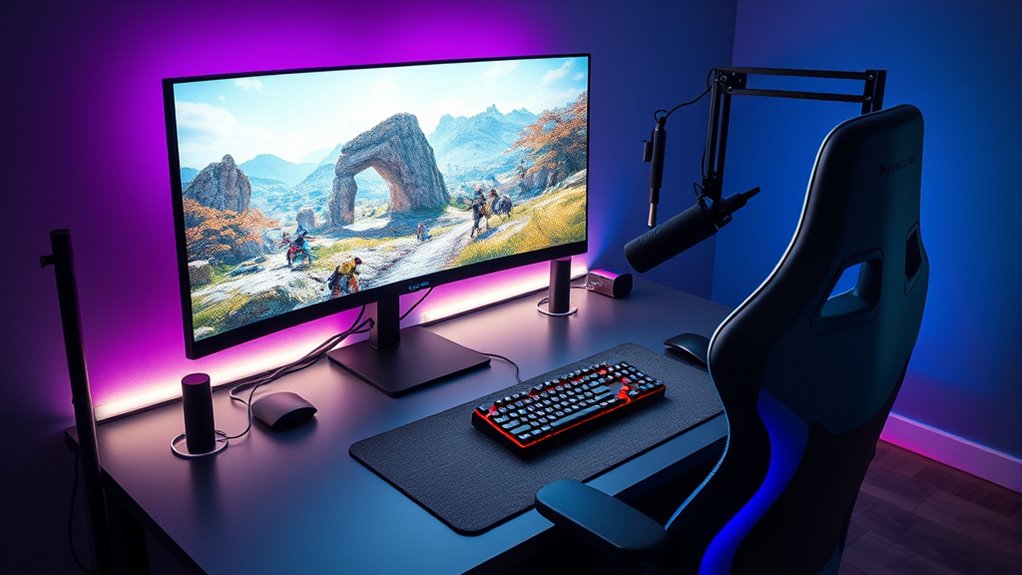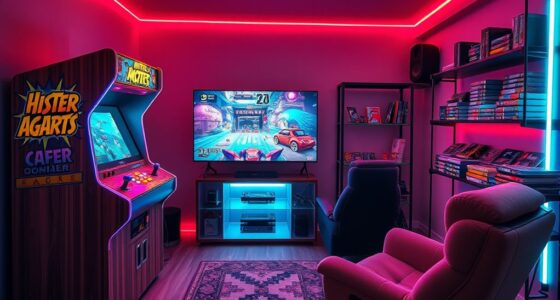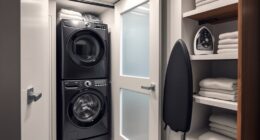To set up your personal gaming station for streaming, start with a high-performance gaming PC or console, a good 1080p or 4K webcam, and a microphone with noise-canceling features. Use streaming software like OBS with settings optimized for 1080p60 at around 6000 Kbps. Make certain your internet upload speed is at least 10 Mbps, preferably wired for stability. Create a clean, well-lit environment, manage cables neatly, and test your audio and video quality. If you keep reading, you’ll discover tips to optimize every aspect of your setup for a pro-streaming experience.
Key Takeaways
- Choose a high-performance gaming PC or console with quality CPU, GPU, and a 120Hz+ monitor for smooth gameplay.
- Set up streaming software like OBS, configure 1080p60 encoding, and connect platforms for seamless broadcasting.
- Incorporate a professional audio mixer and noise-canceling mic to ensure clear, balanced audio during streams.
- Use a wired internet connection with at least 10 Mbps upload speed for stable, high-quality streaming.
- Design a dedicated, soundproofed space with proper lighting, cable management, and ergonomic setup for a professional look.

Setting up a personal gaming station for streaming combines powerful hardware, reliable internet, and careful environment planning to deliver a seamless broadcasting experience. Your primary focus should be on selecting the right gaming PC or console equipped with a high-performance CPU and GPU, like NVIDIA’s RTX series, which supports NVENC encoding. This allows you to handle gameplay and streaming simultaneously without overloading your system. For visuals, opt for a monitor supporting at least 1080p resolution and a 120 Hz refresh rate to guarantee smooth gameplay. If you’re gaming on a console limited to 120 Hz, a 240 Hz monitor might be unnecessary. A quality webcam with a minimum of 1080p resolution is essential for facecam visibility, though a 4K webcam can provide an even more professional look. Pair this with a noise-canceling microphone, such as the AM25X, connected via XLR or USB, to deliver clear audio free from background noise.
In addition, a capture card capable of 1080p60 or 4K with ultra-low latency is vital for streaming console gameplay effectively. This hardware ensures your streams are sharp and responsive, keeping viewers engaged. As for streaming software, OBS Studio is a popular free choice, offering customizable options like Game Capture, Video Capture Device, and Audio Input Capture. Set the encoder to NVENC to offload processing from your CPU, and configure your stream at 1080p at 60 FPS with a bitrate around 6000 Kbps for Twitch. Linking your streaming accounts, such as Twitch or YouTube, is straightforward through their apps or browser code entry systems. Many consoles, like Xbox Series X, support direct streaming via platform-specific apps, simplifying the process.
Managing your audio setup is equally important. Incorporate a professional audio mixer, such as the AMIX40U, to control multiple audio sources and guarantee balanced sound levels. Use noise-canceling microphones to enhance voice clarity and monitor audio levels during streams to prevent clipping or volume issues. Balancing game audio and microphone input keeps your stream engaging and professional. Connecting multiple audio sources through an interface or mixer provides flexibility for more complex sound setups.
Your internet connection must be stable and fast. A minimum upload speed of 10 Mbps is recommended for 1080p60 streaming, but a 1 Gbps plan offers more headroom for higher quality content. Wired Ethernet connections outperform Wi-Fi by reducing latency and packet loss, and prioritizing streaming data through QoS settings on your router helps maintain stability. Regularly test your internet speed and set up backup options or lower bitrates for unforeseen network disruptions.
Additionally, setting up a dedicated streaming space with soundproofing and proper lighting can greatly improve the overall production quality. Finally, environment setup impacts overall quality. Choose a quiet room with minimal background noise and controlled lighting for clear video and audio. Use a monitor arm or stand to optimize desk space and ergonomics. Cooling solutions like laptop stands prevent overheating during long streams. Position your camera and lighting to avoid shadows and ensure your face is well-lit and visible. Proper cable management keeps your space tidy and professional-looking, making your streaming station both functional and visually appealing.
Frequently Asked Questions
What Is the Ideal Room Size for a Gaming Station?
The ideal room size for your gaming station depends on your space needs and comfort. You want enough room to move freely, manage cables easily, and set up lighting and acoustics properly. A room around 10×12 feet or larger offers ample space for a desk, equipment, and good airflow. This size helps reduce echo, allows flexible positioning, and guarantees you stay comfortable during long gaming or streaming sessions.
How Do I Optimize Internet Speed for Streaming?
To optimize your internet speed for streaming, start by ensuring your upload speed is at least 15 Mbps for good quality. Use an Ethernet connection instead of Wi-Fi for stability, and choose a high-quality router to reduce latency. Regularly test your speed, prioritize your streaming traffic, and limit other devices using your network. Upgrading your equipment and working with a reliable ISP also help maintain consistent, fast internet for smooth streams.
What Are the Best Ergonomic Accessories for Long Gaming Sessions?
To stay comfortable during long gaming sessions, you should invest in ergonomic accessories like an adjustable chair such as the Autonomous ErgoChair Pro or Secretlab Titan Evo Nanogen for proper support. Add a standing desk or ergonomic wrist rests to reduce strain. Use monitor arms to keep screens at eye level, and incorporate cushions for extra comfort. Remember to take breaks, maintain good posture, and stretch regularly to prevent fatigue and discomfort.
How Do I Manage Ambient Lighting to Prevent Glare?
Managing ambient lighting is like wielding a magic wand to prevent glare. You should position lights behind your monitor or TV at angles that avoid reflections. Use diffusers or softboxes to disperse light evenly, and opt for dimmable, color-temperature-matched lights to reduce eye strain. RGB or smart lighting lets you customize brightness and color, creating an immersive atmosphere without causing glare, so your gaming experience stays sharp and comfortable.
What Are Cost-Effective Options for High-Quality Audio?
For high-quality audio on a budget, you can choose from several options. Consider the Logitech Z906 for immersive 5.1 surround sound if you want room-filling audio, or the Creative Pebble Plus for a budget-friendly 2.1 setup with enhanced bass. In-ear monitors like the Simot EW200 offer detailed sound for precise cues. Budget headsets like the Jayab Nightfalls provide decent sound and mic quality, perfect for casual streaming and gaming.
Conclusion
Think of your gaming station as a ship, ready to set sail on endless adventures. With each piece of equipment, you’re building the sturdy hull, the guiding compass, and the powerful engine to navigate the streaming seas. When you invest time and effort, you’re not just creating a setup—you’re crafting a vessel that carries your passion and dreams. Stay prepared, stay curious, and enjoy the voyage ahead. Your journey to greatness begins now.









